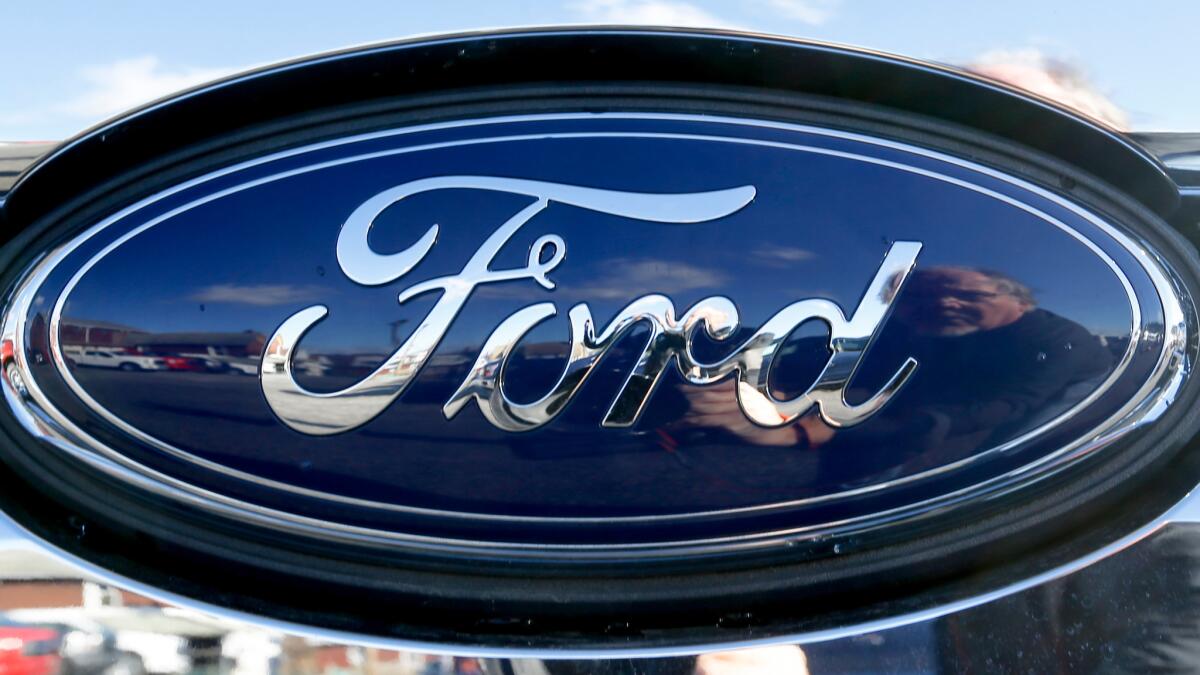In race to get driverless cars on the road, Ford speeds ahead

- Share via
Reporting from Palo Alto — You’re out on the town. You hail a taxi with an app. A cushy vehicle shows up with no steering wheel, no gas pedal, no brake pedal and no driver.
You’ve heard those ambitious plans spelled out for some pie-in-the-sky future.
Now, Ford Motor Co. says it will make it happen, and soon.
The Detroit automaker revealed in broad strokes Tuesday an ambitious strategy to make fully autonomous cars available for sale by 2021. At first they’ll be used for ride sharing and ride hailing, with sales to individual drivers an indeterminate number of years after that, Ford Chief Executive Mark Fields said.
“This is a transformational moment in our industry and it is a transformational moment for our company,” Fields said outside Ford’s Palo Alto research center in Silicon Valley. “The next decade will be defined by the automation of the automobile, and we see autonomous vehicles as having as significant an impact on society as Ford’s moving assembly line did 100 years ago.”
In fact, the real transformation will occur when Ford delivers on its plans, or when another company beats it to the punch. All of the major automakers are working on such technology. So is Alphabet, the parent company of Google, and, possibly, Apple. Earlier this year, General Motors bought an autonomous car start-up, Cruise Automation, and announced it would work with Lyft, which GM partly owns, to develop driverless taxis.
The fast-approaching date for driverless cars also ratchets up the pressure on state and federal lawmakers to come up with guidelines. Last month, Transportation Secretary Anthony Foxx said his department will issue new guidelines on the vehicles this summer. It has been working with companies developing driverless and partly autonomous cars to adapt existing safety rules to the new technologies.
But, in the race to bring driverless cars to market, Ford is the first to commit to a date.
“The business opportunity here is absolutely huge,” said Fields, a Ford veteran who was named CEO in 2014. The driverless car is part of a major strategic reorientation at Ford that “will allow us to get a growing share of [the] transportation-as-a-service market.”
By that, he means vehicles, software and services that cater to a market where people need to navigate independently through increasingly packed cities around the world, but don’t want or can’t afford their own cars, or are physically unable to drive them.
To make it happen, Ford also announced acquisitions of and investments in a few driverless technology companies, but did not identify any partnerships or even discussions with existing ride-hailing companies, such as Lyft and Uber. Asked for details, Fields said, “There will be things we do on our own; there will be things we do with others.”
The first deployments, he said, will be in crowded urban areas and require partnerships with government leaders on regulations and infrastructure needed to support driverless cars. For instance, right now such experimental vehicles need clear lane markings to operate.
He figures local governments will go along: “It’s an economic development issue” for cities that want to keep central shopping districts healthy.
The CEO, 55, said he’s confident of Ford’s ability to develop the technology to meet the deadline. But consumer acceptance is another issue. By rolling out the cars in ride-hailing capacities first, he said, consumers will have time to build trust and confidence in the vehicles.
He criticized competitors for promising too much with current “driver-assist” technology, an oblique swipe at Tesla Motors, whose attitude toward its own driver-assist feature, named Autopilot, has come under criticism.
“They throw these terms around very liberally,” he said.
Tesla has been facing questions about its Autopilot system since the death of a Model S driver in Florida in May. On the afternoon of May 7, in clear, dry conditions, a Tesla Model S driven by 40-year-old Joshua Brown slammed into a tractor trailer attempting to turn in front of it.
The accident sheared the roof off the car, which skidded under the truck and off the road, plowing through two wire fences before crashing into a utility pole, the accident report said.
The crash of the car, which was using the still-in-beta Autopilot, highlighted what some say is a gaping pothole on the road to self-driving vehicles: the lack of federal rules.
Automakers do not need to get the technology approved by the National Highway Traffic Safety Administration before rolling it out to the public. They just have to attest that their vehicles meet federal safety standards -- yet there still are no such standards for autonomous driving features.
That enables carmakers to, at their own discretion, roll out features when they deem them to be ready to hit the road.
Critics, lawmakers and safety advocates say carmakers should not be using their customers as guinea pigs. They’re questioning whether the companies are moving too fast and say regulators should put the brakes on a nascent technology that might have been rolled out too hastily.
Ford, Fields said, will completely skip what’s known as “level 3” autonomous cars, which would put the driverless system in control of the vehicle but expect the human driver to take over if need be. “We couldn’t get confident” with that kind of human-machine interaction, he said.
Instead, Ford will sell cars in which the driver is responsible for all systems, and driverless cars in which the passengers have no responsibility at all.
Ford also plans to expand its research center in Palo Alto by doubling the staff there, to 260, in order to push the company toward the deadline.
“This whole thing is really significant,” said Ed Kim, vice president of industry analysis at market research firm AutoPacific. “It is a great technological accomplishment to be able to offer such a level of autonomy in such a short amount of time.”
Ford also announced related business deals:
— A $75-million investment in Velodyne LiDAR Inc., a Northern California company that specializes in lidar, a technology that uses light to detect objects. Baidu, the Chinese Internet giant with an artificial-intelligence lab in Silicon Valley, will also kick in $75 million.
— The acquisition of SAIPS, an Israeli computer vision company.
— An investment in Civil Maps, which applied artificial intelligence to digital map making.
— An exclusive licensing agreement with Nirenberg Neuroscience to use its machine vision technology, which it says has been used to restore sight to the visually impaired.
Michelle Krebs, senior analyst at Autotrader, cautioned that Ford now has to meet its target date for rolling out the vehicles.
“We’ve got to be careful about ‘first,’ ‘biggest,’ ‘most,’” she said. “These are plans.… We’ve been waiting for Ford to make some announcement of where they are,” Krebs said. “GM’s been getting a lot of publicity, and Wall Street has been asking, ‘What’s Ford’s plan?’”
Fields acknowledges that the carmaker, the second largest in the country, has been under pressure to reveal its autonomous vehicle efforts.
“We’ve taken our time to talk about our plans, and we’ve been criticized for that,” he said. “We are not in a race to make announcements.”
Shares of Ford fell 9 cents, or less than 1%, to $12.34 on Tuesday.
Times staff writer Jim Puzzanghera in Washington contributed to this report.
ALSO
Will that red light end soon? Audi’s countdown clock can tell you
Lyft CEO Logan Green has a plan that’s far bigger than ride-hailing
Millions of cars’ keyless entry systems can be hacked, security experts find
UPDATES:
6:20 p.m.: This article has been revised for additional updates and for clarity.
12 p.m.: This article was updated with details from Ford’s news conference in Palo Alto, Calif.
9:20 a.m.: This article was updated with staff reporting.
This article was originally published at 8 a.m.
More to Read
Inside the business of entertainment
The Wide Shot brings you news, analysis and insights on everything from streaming wars to production — and what it all means for the future.
You may occasionally receive promotional content from the Los Angeles Times.












